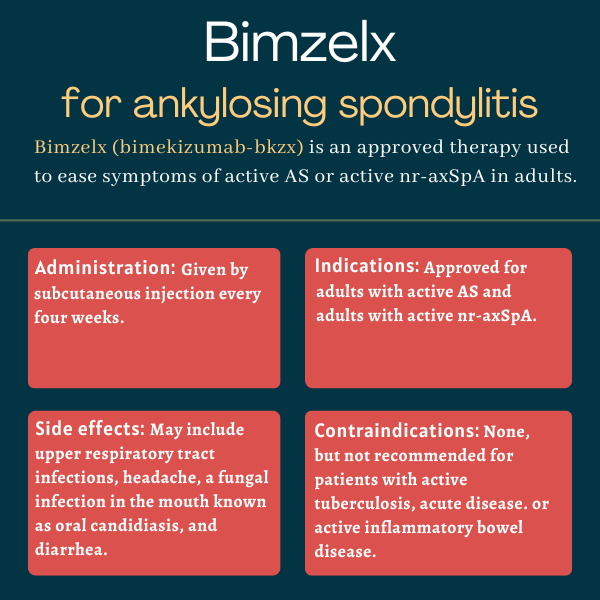 Discussion
Discussion
Bimzelx for ankylosing spondylitis
Last updated Dec. 3, 2024, by Marisa Wexler, MS

What is Bimzelx for ankylosing spondylitis?
Bimzelx (bimekizumab-bkzx) is a subcutaneous, or under-the-skin, injection therapy that’s approved for easing symptoms in adults with active ankylosing spondylitis (AS) or active nonradiographic axial spondyloarthritis (nr-axSpA) with signs of inflammation.
AS and nr-axSpA are forms of axial spondyloarthritis, a chronic inflammatory condition, and have similar symptoms. The difference between the two is that joint damage isn’t detectable on X-rays in people with nr-axSpA, whereas in AS, or radiographic axSpA, joint damage can be seen.
The therapy, sold by UCB Biopharm, is also approved to treat other inflammatory diseases, namely plaque psoriasis, psoriatic arthritis, and hidradenitis suppurativa.
Therapy snapshot
| Brand name: | Bimzelx |
| Chemical name: | Bimekizumab-bkzx |
| Usage: | Approved for adults with active AS or nr-axSpA |
| Administration: | Subcutaneous injection |
How does Bimzelx work?
AS and nr-axSpA are both conditions characterized by out-of-control inflammation that causes damage to joints, particularly in the lower back, with pain and stiffness also affecting the hips and the buttocks.
Inflammation is a complex biological phenomenon involving the activity of many different types of cells. Signaling molecules called cytokines are released by cells to communicate with each other and coordinate inflammatory responses. In inflammation-driven diseases like AS and nr-axSpA, cytokine levels typically become skewed, which plays a key role in driving the disease.
Bimzelx is an antibody-based medication designed to block two members of the interleukin-17 (IL-17) family of pro-inflammatory cytokines — specifically IL-17A and IL-17F. These signaling molecules play a central role in driving inflammation in AS and other autoimmune conditions, so by blocking their activity, Bimzelx is expected to ease the inflammation that causes AS and nr-axSpA.
Who can take Bimzelx?
Bimzelx was approved by the U.S. Food and Drug Administration (FDA) in September 2024 as a treatment for adults with active AS and adults with active nr-axSpa who show objective signs of inflammation. The therapy also is approved in the European Union for these indications.
Other approved indications for Bimzelx in the U.S. include plaque psoriasis, psoriatic arthritis, and hidradenitis suppurativa, all of which are inflammatory disorders.
Who should not take Bimzelx?
The prescribing information for Bimzelx does not list any contraindications; however, the therapy is not recommended for use by individuals with active tuberculosis infection, those with active inflammatory bowel disease (IBD), or those with acute liver disease or cirrhosis (severe liver scarring).
How is Bimzelx administered?
For both AS and nr-axSpA, the approved dosing schedule is 160 mg administered every four weeks by subcutaneous injection. Bimzelx is available in two dose strengths: 160 mg of the medication in 1 mL of liquid, and 320 mg of the drug in 2 mL of liquid.
The medication comes in a single-dose prefilled syringe or a single-dose prefilled autoinjector, each containing the therapy in a clear to slightly opalescent, colorless to pale brownish-yellow solution.
Before starting the therapy, patients should undergo tests for tuberculosis and measures of liver markers, and also get all recommended vaccinations.
Bimzelx should be stored in the refrigerator. About 30 to 45 minutes before the injection, it should be removed from the refrigerator and allowed to warm to room temperature. The autoinjector or syringe should be kept in the carton while it warms to protect the medication from light.
The treatment should be administered under the guidance of a healthcare professional; patients may self-administer the injection if they have been trained to do so.
The injection may be given under the skin of the abdomen or upper thighs. If given by a healthcare provider or caregiver, it also may be administered under the skin of the upper arms. Different sites should be used if two separate 160 mg injections are needed to achieve the recommended dose. The injection site should be rotated at each injection. Bimzelx should not be injected within two inches of the navel or into skin that is bruised, red, hard, thick, scaly, or tender.
If a scheduled dose of Bimzelx is missed, it should be administered as soon as possible, and then dosing should resume at the regularly scheduled time.

Bimzelx in clinical trials
The FDA’s approval of Bimzelx for AS and nr-axSpA was based on data from two global Phase 3 clinical trials: BE MOBILE 1 (NCT03928704) and BE MOBILE 2 (NCT03928743). BE MOBILE 1 enrolled 254 adults with nr-axSpA, while BE MOBILE 2 involved 332 adults with AS.
BE MOBILE 1 and BE MOBILE 2 TRIALS
In both studies, eligible participants had active disease, and also needed to have tried and failed to adequately respond to treatment with two nonsteroidal anti-inflammatory drugs (NSAIDs) or be unable to take NSAIDs. Such drugs belong to a common class of anti-inflammatory medicines, which includes ibuprofen.
In each of the Phase 3 trials, patients were randomly assigned to receive injections of either Bimzelx or a placebo every four weeks for 16 weeks, or about four months. Thereafter, all participants were given Bimzelx for up to week 52, or one year altogether.
For both trials, the main goal was to determine whether more patients on Bimzelx than on the placebo achieved an improvement of at least 40%, or at least two units, in three of four domains that are part of a standard disease severity measure called Assessment of Spondyloarthritis International Society, or ASAS40. The four domains were patients’ global assessment of disease activity, spinal pain, an index assessing the level of functional ability, and morning stiffness.
The results showed that, after 16 weeks, significantly more patients on Bimzelx than on the placebo achieved ASAS40 in both the nr-axSpA trial (47.7% vs. 21.4%) and the AS trial (44.8% vs. 22.5%). Responses were similar whether or not patients had been on anti-TNF alpha therapy, the data showed. Differences between the Bimzelx and the placebo groups were evident within the first month of treatment.
Bimzelx also outperformed the placebo in improving patients’ quality of life, as measured by scores on the Ankylosing Spondylitis Quality of Life Questionnaire (ASQoL), as well as other measures of disease activity.
The ASAS40 response was sustained for up to one year, with benefits seen across all domains. At one year, Bimzelx resulted in less inflammation and fewer structural changes on MRI scans of the sacroiliac joints, which join the spine to the pelvis. Also at that time point, the responses of patients switching from the placebo to Bimzelx at week 16 were comparable to those of patients taking Bimzelx for the duration of the study.
Ongoing studies
Participants completing either BE MOBILE trial had the option to enter into an extension study, called BE MOVING (NCT04436640), which is still underway and slated to run through 2026. All patients in the extension study are being treated with Bimzelx; BE MOVING aims to evaluate the long-term safety and efficacy of the therapy.
An analysis including two-year data from BE MOVING, but also pooling data from the previous Phase 2b BE AGILE clinical trial (NCT02963506) and its open-label extension study (NCT03355573), showed that Binzelx had a positive safety profile, consistent with prior reports.
As for efficacy, clinical response was sustained at two years among adults with AS or nr-axSp who entered BE MOVING from the BE MOBILE trials, as assessed with the ASAS40 measure. Similar findings were obtained among those who had achieved low disease activity or inactive disease over the first 16 weeks of the parent trials. In addition, there was generally minimal progression of structural damage, based on X-ray data.
Common side effects of Bimzelx
In people with active AS, the most common side effects of Bimzelx were:
- upper respiratory tract infection
- oral candidiasis, or an infection caused by a fungus called Candida albicans
- headache
- diarrhea
- injection site pain
- rash
- vulvovaginal mycotic infection, which usually is caused by Candida albicans but can also be caused by other Candida species or yeasts.
In people with nr-axSpA, the most common side effects of Bimzelx were:
- upper respiratory tract infection
- oral candidiasis
- headache
- diarrhea
- cough
- fatigue
- pain in muscles and/or bones
- tonsilitis, or tonsil inflammation
- increased levels of transaminase, a marker of liver damage
- urinary tract infection.
Suicidality
Bimzelx has been reported to increase the risk of suicidal thoughts and behaviors in some patients, although trial data showed no suicidal thoughts among AS or nr-axSpA patients. Such potential risks should be carefully weighed when considering the therapy’s use in individuals who have a history of depression or suicidal tendencies.
Patients and their loved ones should be advised to be on the lookout for potential behavioral changes while taking Bimzelx. If suicidal thoughts or actions occur, patients should immediately seek medical attention, including mental health care as appropriate, and the benefits and risks of continuing treatment should be re-evaluated.
Infections
Bimzelx can increase the risk of infections. The therapy should not be started in individuals with clinically important active infection until such infection is resolved or adequately treated; the risks of Bimzelx should be considered carefully in those with a history of chronic infection. If patients on Bimzelx develop an infection, they should seek medical attention straightaway; it may be necessary to discontinue Bimzelx until the infection is resolved.
Tuberculosis
Patients should be tested for tuberculosis before starting Bimzelx, and the therapy should not be given to individuals with an active tuberculosis infection. In patients who have a known or possible latent tuberculosis infection, treatment with anti-tuberculosis medications is recommended prior to starting Bimzelx. Patients should be carefully monitored for signs of active tuberculosis infection during and after Bimzelx treatment.
Liver damage
Bimzelx may cause an increase in markers of liver damage. Liver health markers should be checked before patients begin treatment, and the medication is not recommended for individuals with serious liver injury. Liver health markers should be monitored periodically while patients are taking Bimzelx. If signs of liver injury appear, the treatment should be paused while patients are assessed for liver injury; if treatment-related liver injury is confirmed, Bimzelx should be permanently discontinued.
Inflammatory bowel disease
Cases of IBD have been reported in patients treated with Bimzelx. The therapy is not recommended for patients with active inflammatory bowel disease. Patients taking Bimzelx should be monitored for signs of new or worsening IBD, and if these occur, the treatment should be discontinued.
Vaccination
Before starting treatment with Bimzelx, patients should receive all recommended vaccines. It’s recommended that live vaccines (such as those containing a live virus) should not be given to patients on Bimzelx.
Use in pregnancy and breastfeeding
There is currently not enough data on the use of Bimzelx in people who are pregnant or breastfeeding to be sure of its safety in these situations. Decisions on whether or not to use Bimzelx in pregnant or nursing patients should be made by carefully weighing the potential benefits and risks of such treatment.
Animal studies of the therapy’s use during pregnancy did not reveal any noteworthy safety issues. Because Bimzelx is an antibody therapy, it’s expected to be able to cross the placenta to a developing fetus; as such, caution should be taken with the use of live vaccines in newborns who were exposed to the therapy during pregnancy.
Ankylosing Spondylitis News is strictly a news and information website about the disease. It does not provide medical advice, diagnosis, or treatment. This content is not intended to be a substitute for professional medical advice, diagnosis, or treatment. Always seek the advice of your physician or other qualified health provider with any questions you may have regarding a medical condition. Never disregard professional medical advice or delay seeking it because of something you have read on this website.
Recent Posts
- Writing about AS has shown me the power of personal stories October 7, 2025
- New biomarker may predict who benefits from AS therapy: Study September 8, 2025
- Filgotinib safe, effective in patients with different forms of axSpA: Trial August 11, 2025
- How physical therapy has improved my life with ankylosing spondylitis July 22, 2025
- Physical activity linked to better health, quality of life in axSpA July 14, 2025
Related articles
-
 Discussion
Discussion
-



